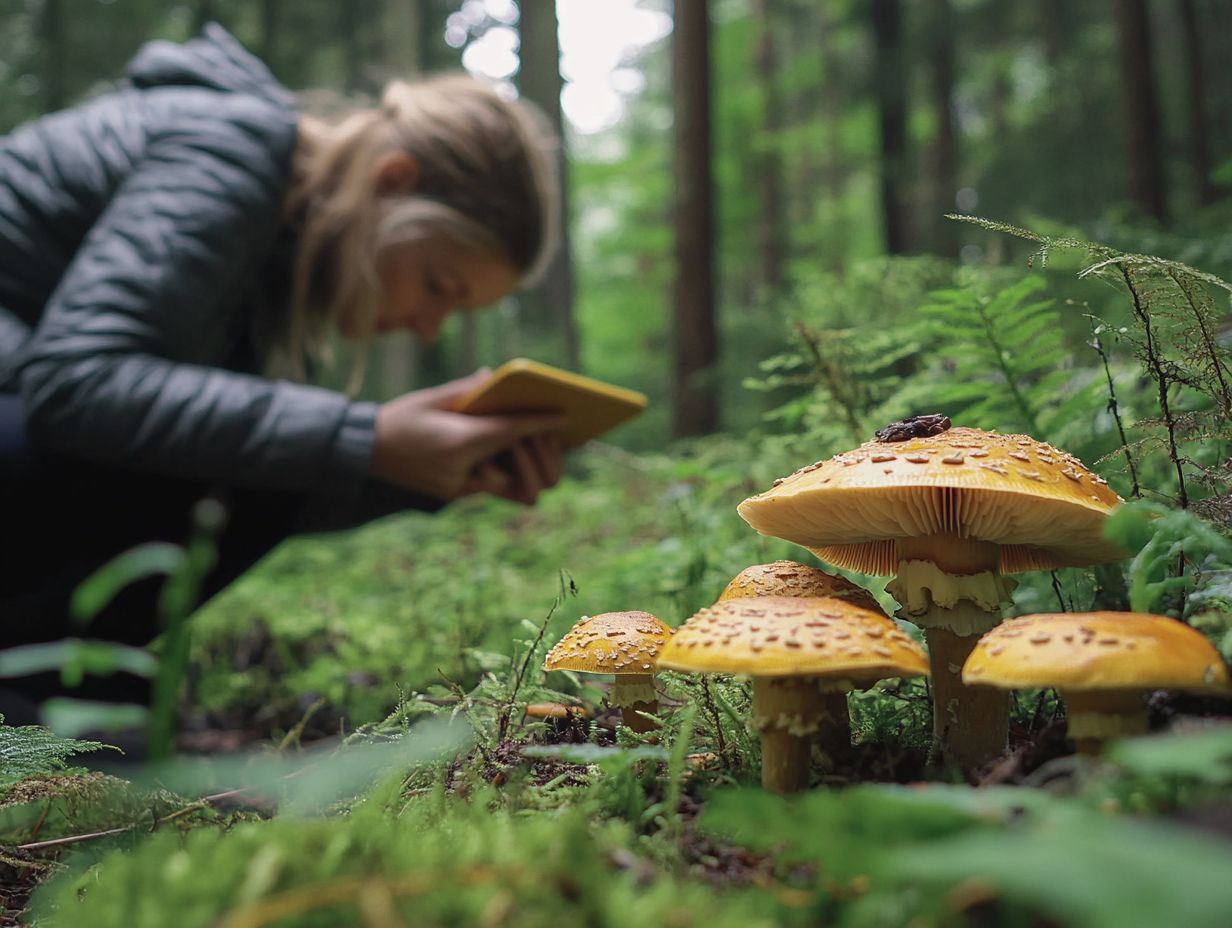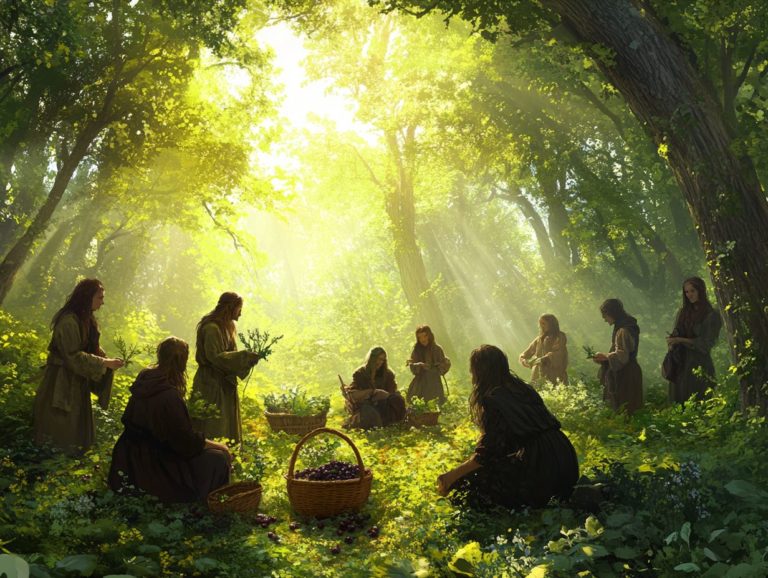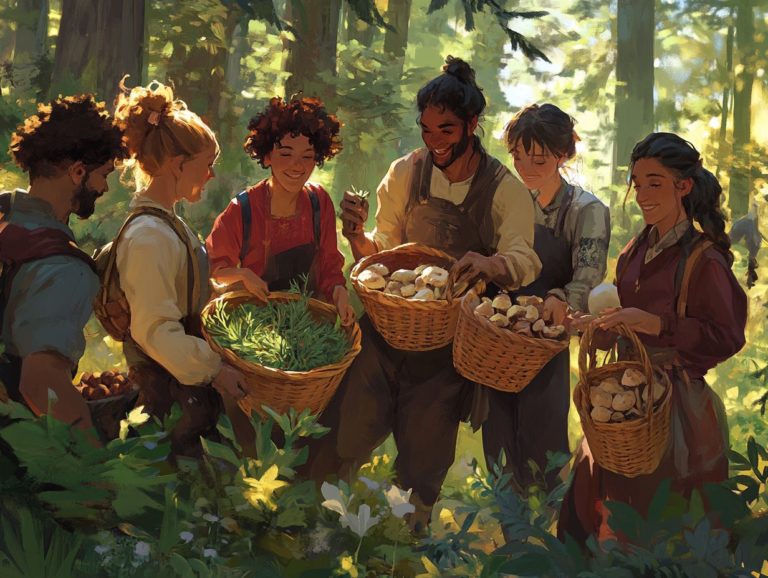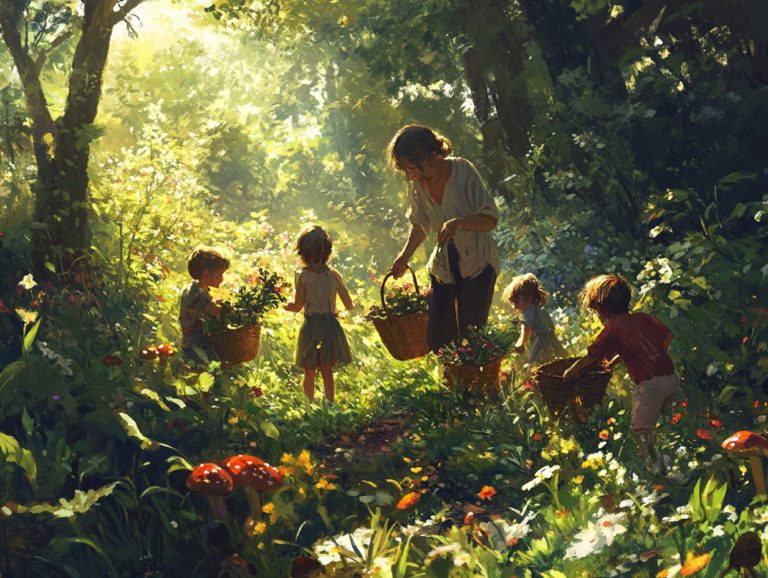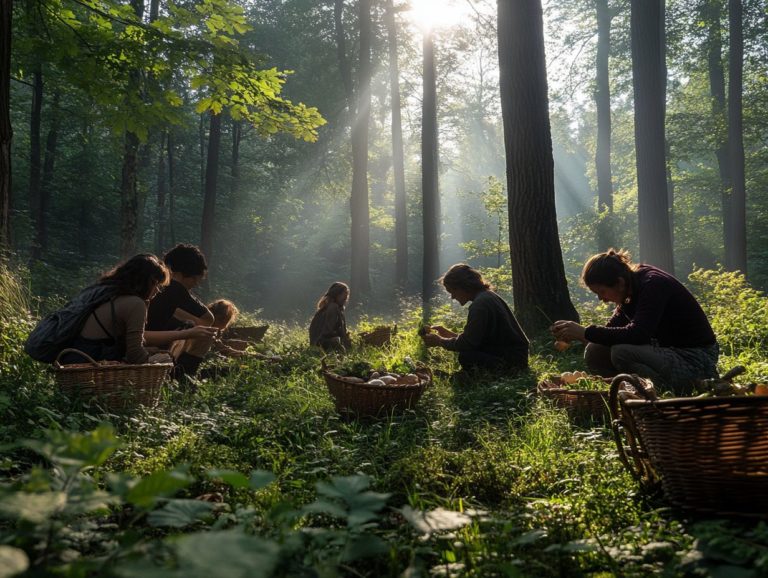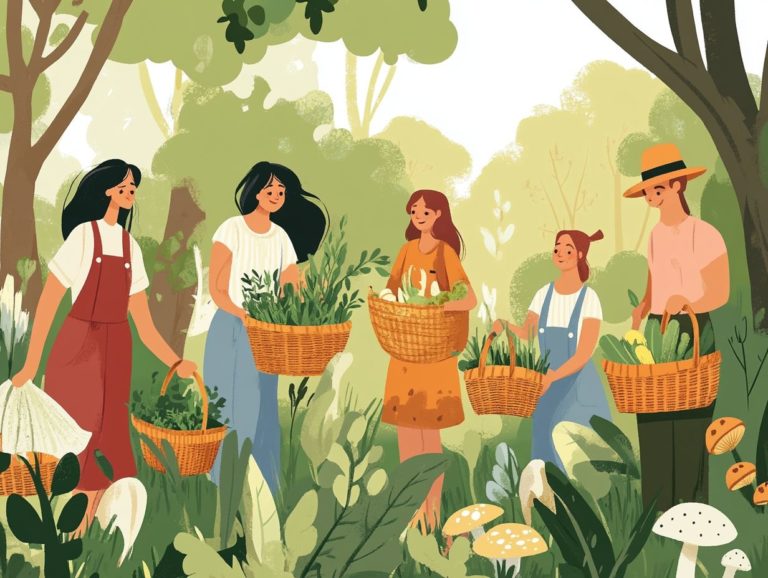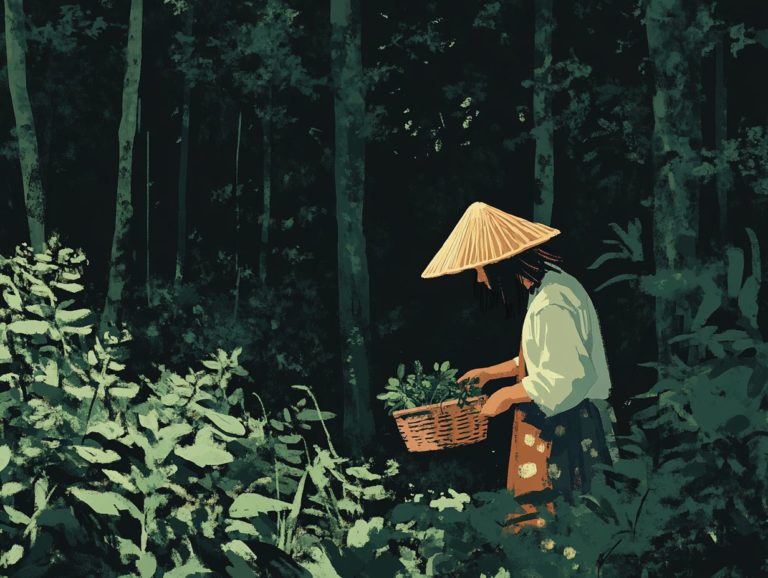Top 7 Risks of Unsafe Foraging Practices
Foraging presents an exhilarating adventure, allowing you to connect with nature while uncovering a treasure trove of wild flavors. However, approaching this practice with caution is essential. Though the thrill of discovering edible plants and mushrooms can be captivating, significant risks lurk beneath the surface.
This article delves into the top seven dangers of unsafe foraging, from the threat of accidental poisoning to potential legal ramifications. It also highlights common mistakes, provides safety tips, and suggests alternatives to ensure your foraging experience remains both pleasurable and secure.
Contents
- Key Takeaways:
- 1. Accidental Poisoning
- 2. Allergic Reactions
- 3. Ingesting Harmful Bacteria or Parasites
- 4. Mistaking Poisonous Plants for Edible Ones
- 5. Damage to Ecosystems
- 6. Legal Consequences
- 7. Risk of Injury
- What Is Foraging and Why Is It Popular in the Context of Foraging Theory?
- Frequently Asked Questions
- What are the top 7 risks of unsafe foraging practices?
- How does ingestion of toxic or poisonous plants pose a risk in foraging?
- In what ways can unsafe foraging practices lead to exposure to dangerous wildlife?
- What should I do if I get lost or injured while foraging?
- How can I avoid consuming contaminated food or water while foraging?
- Why can foraging harm the environment?
- What laws and regulations should I be aware of when foraging?
Key Takeaways:
1. Accidental Poisoning
Accidental poisoning poses significant risks to outdoor enthusiasts who may inadvertently consume hazardous plants or fungi. Such mistakes can lead to serious health issues caused by toxins and pollution. The importance of accurate plant identification cannot be overstated, especially when considering the dangers associated with wild edibles.
Plants like poison ivy, known for its irritating oils, and poison hemlock, which can be deadly if ingested, highlight the need for education about local flora. Wildlife, such as red foxes, though resilient, can also suffer consequences from consuming toxic plants, impacting their health and reproductive success.
These incidents can create ripple effects within local ecosystems. When certain species decline, it can lead to imbalances in the food chain. Therefore, mastering proper plant identification safeguards your well-being and plays a crucial role in preserving wildlife populations and maintaining ecological harmony.
2. Allergic Reactions
Allergic reactions can arise from consuming certain wild plants, which may contain compounds that trigger sensitivities. Understanding the nutritional value and medicinal properties of these plants becomes vital for any outdoor enthusiast.
Not everyone will respond the same way to wild edibles. While some may have only mild reactions, others could experience severe symptoms like hives, swelling, or even difficulty breathing. Common allergens often lurk in wild plants, especially those from the Asteraceae family, such as daisies, which can provoke reactions in sensitive individuals.
To reduce risks, it’s essential to learn how to identify plants that contain these allergens. Observe features like leaf structure, flower arrangements, and scents these can provide crucial clues. Adopting a cautious approach when introducing new edible plants into your diet is wise; thorough research and gradual trial can prevent unwelcome surprises while you explore the great outdoors.
Join a local foraging group to learn from experienced foragers!
3. Ingesting Harmful Bacteria or Parasites
Ingesting harmful bacteria or parasites poses a significant risk for anyone who engages in gathering wild food, especially when harvesting from unsafe areas. This could seriously harm your health and impact your food security.
Bacteria like E. coli and Salmonella, as well as parasites such as Giardia, may be found in wild edibles if they re gathered from polluted waters or areas frequented by animals. You must learn safe harvesting techniques now to protect your health. This includes washing and cooking any plants you collect and maintaining proper hygiene throughout the process.
Understanding the environmental impacts of gathering wild food is essential. Consider how soil and water sources can become contaminated due to agricultural runoff or waste. By being mindful of these factors, you can ensure that the foods you forage are not only safe to eat but also sustainable for future generations.
4. Mistaking Poisonous Plants for Edible Ones
Mistaking poisonous plants for edible ones is a common pitfall for foragers. This highlights the necessity for effective foraging strategies and safe practices to avoid plant misidentification and health risks.
Familiar edible plants, such as wild garlic or elderberries, often have toxic counterparts like lily of the valley or poisonous elder. These can mislead even the most experienced foragers. This reality underscores the importance of accurate plant identification and understanding their distinctive features.
Engaging in foraging workshops led by experienced gatherers is essential. These sessions not only reveal how to identify edible varieties but also provide tips on how to forage safely. As a novice, you ll greatly benefit from hands-on experiences, learning to recognize these plants firsthand while building the confidence to explore nature responsibly.
5. Damage to Ecosystems
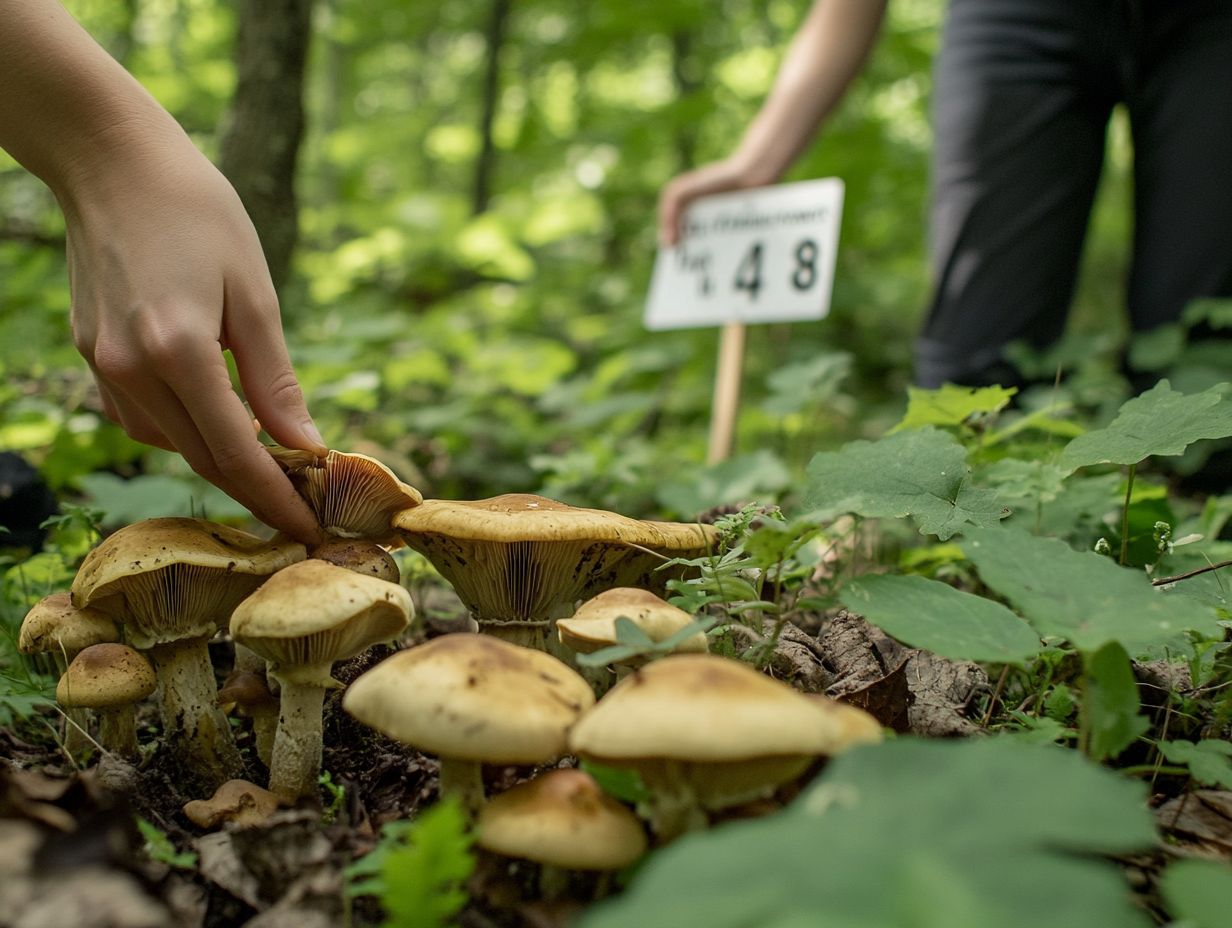
Damage to ecosystems can occur when your gathering practices lack sustainability. This can lead to imbalances in local wildlife populations and resource patches, compromising the overall health of the environment and its ability to provide nutritious food sources.
If you harvest too aggressively or neglect seasonal patterns, you may unintentionally deplete certain species. This disrupts the delicate balance that sustains diverse ecosystems. Such exploitation threatens the availability of these resources for future generations and hinders the regeneration of essential plant and animal communities.
Embracing sustainable gathering methods those that prioritize habitat preservation and promote healthy ecosystems is crucial. This helps keep wildlife populations stable and ensures local ecosystems thrive. Ultimately, cultivating a culture of responsible foraging is vital for wildlife conservation and environmental sustainability.
6. Legal Consequences
Engaging in illegal foraging practices can lead to serious legal repercussions. It is essential for you to be aware of the regulations in place that protect wildlife conservation and prevent environmental degradation from harmful harvesting methods.
Understanding the specific legal frameworks governing foraging in various regions is vital for anyone interested in gathering wild plants. Some areas may impose limits on how much you can harvest or designate protected species that are entirely off-limits. These laws are designed to preserve biodiversity, the variety of different plant and animal life, and maintain the balance of ecosystems.
By following these regulations, you not only engage in sustainable practices but also build a deeper connection with nature. This ensures that your foraging activities can thrive into the future. Compliance is not just a legal necessity; it is a moral commitment to being responsible stewards of the environment.
7. Risk of Injury
The risk of injury while foraging can arise from a variety of factors, including navigating treacherous terrain, using improper harvesting techniques, and encountering hazardous plants. A keen understanding of foraging behaviors is essential to ensure your safety and minimize potential accidents.
For instance, slips and trips are common pitfalls when traversing uneven ground. Losing your footing while reaching for that enticing wild edible can happen in the blink of an eye. Certain plants may pose unique dangers, like thorny bushes or poisonous varieties that can lead to severe skin irritation and other health issues. It s vital for you to familiarize yourself with safe patches that are free from these hazards.
Equally important is the need to employ safe harvesting techniques. Using the right tools and staying aware of your surroundings can significantly reduce the likelihood of mishaps while you relish the bounty of nature.
What Is Foraging and Why Is It Popular in the Context of Foraging Theory?
Foraging, grounded in the principles of foraging theory, means finding wild food and other sources nestled within natural environments. This practice appeals to outdoor enthusiasts who seek a deeper connection with nature while embracing the benefits of sustainable food practices.
What was once essential for survival has experienced a remarkable renaissance in today’s society. Many people are eager to reconnect with their ancestral heritage. As awareness of food sourcing and environmental impact grows, foraging transcends mere hobby status; it becomes part of a broader movement toward sustainability.
You might find yourself drawn to the thrill of discovery as you learn to identify various plants and fungi while gaining insights into local ecosystems. This journey fosters a sense of stewardship and appreciation for the environment. It inspires you to nurture your surroundings and champion biodiversity. In doing so, you contribute to a richer narrative between humanity and the natural world.
What Are the Benefits of Foraging?
Foraging presents a wealth of benefits, granting you access to nutrient-rich wild edibles that not only bolster your health but also promote sustainable practices. These practices nurture an appreciation for nature and biodiversity.
As you engage in this timeless activity, you ll uncover a variety of plants like dandelion greens, which are brimming with vitamins A, C, and K. They have a long-standing reputation for supporting liver health. Don t overlook stinging nettle; it s a nutritional powerhouse rich in iron and can even provide relief from allergies thanks to its anti-inflammatory properties.
Foraging enriches your diet with these natural treasures while fostering a deeper connection to the environment. It enhances your ecological awareness. By mindfully harvesting wild plants, you embrace a sustainable lifestyle that shows respect for nature s bounty and contributes to the preservation of local ecosystems.
What Are the Most Common Mistakes Made During Foraging?
Common mistakes in foraging often arise from insufficient plant identification and a lack of awareness regarding the risks of foraging alone. This can lead to unsafe foraging behaviors and potential health hazards.
You should dedicate time to learning about the plants you encounter. Resources like field guides and local workshops can be invaluable in this journey. Misidentifying edible plants can have serious repercussions, so cross-referencing with multiple reliable sources will greatly enhance your confidence and knowledge.
Stay aware of your surroundings and avoid areas that may be polluted, such as urban settings or locations near heavy traffic. By practicing patience and diligence during your foraging adventures, you can significantly enhance your experience while ensuring safety.
How Can One Ensure Safe Foraging Practices?
Ensuring safe foraging practices requires a commitment to thorough plant identification, proper harvesting techniques, and readiness for any emergencies that may occur during your nature explorations.
Before you set foot into the wild, it’s essential to equip yourself with reliable field guides or smartphone apps that can help distinguish edible plants from their toxic counterparts. Understanding the typical growth patterns, seasonal variations, and regional specifics of these plants is crucial to avoid confusion or misidentification.
Packing a well-stocked foraging kit complete with sharp knives, gloves, and containers can significantly enhance your experience while ensuring safety. Always know first aid procedures for minor injuries, as well as the contact information for poison control in case of accidental ingestion. This should always be a priority.
These thoughtful preparations elevate the enjoyment of your foraging adventures and greatly minimize the associated risks.
What Are the Most Dangerous Plants to Avoid When Foraging?
Identifying and steering clear of dangerous plants is essential for safe foraging. Certain species, like poison ivy and poison hemlock, pose significant health risks and can lead to severe consequences if misidentified or ingested.
These harmful plants often have characteristics that mimic benign species, making accurate identification crucial for both novice and seasoned foragers. For example, poison ivy can easily be confused with harmless shrubs, while the deceptively attractive flowers of poison hemlock might entice the unwary.
Act now to educate yourself about the visual traits of these perilous plants such as leaf shapes, flower arrangements, and overall structures to navigate your surroundings more effectively. Increasing your awareness cultivates a safer foraging experience and deepens your appreciation for nature’s diverse flora, allowing for a smarter and more informed interaction with the wild.
What Are the Alternatives to Foraging?
While foraging offers a wealth of benefits, exploring alternatives like purchasing locally sourced food and embracing sustainable agricultural practices can deliver nutrient-rich options without the risks often associated with wild harvesting.
Engaging with community-supported agriculture (CSA) allows you to forge a direct connection with local farmers, ensuring that you receive fresh produce while cultivating a sense of community. Visiting farmers’ markets not only supports local economies but also gives you the power to choose organic and seasonal items, promoting a healthier diet.
Home gardening presents a unique opportunity for you to grow your own food, putting you in control of your food sources. By focusing on these alternatives, you address food security concerns and contribute to environmental health, championing practices that protect our ecosystems and enhance biodiversity.
Frequently Asked Questions
What are the top 7 risks of unsafe foraging practices?
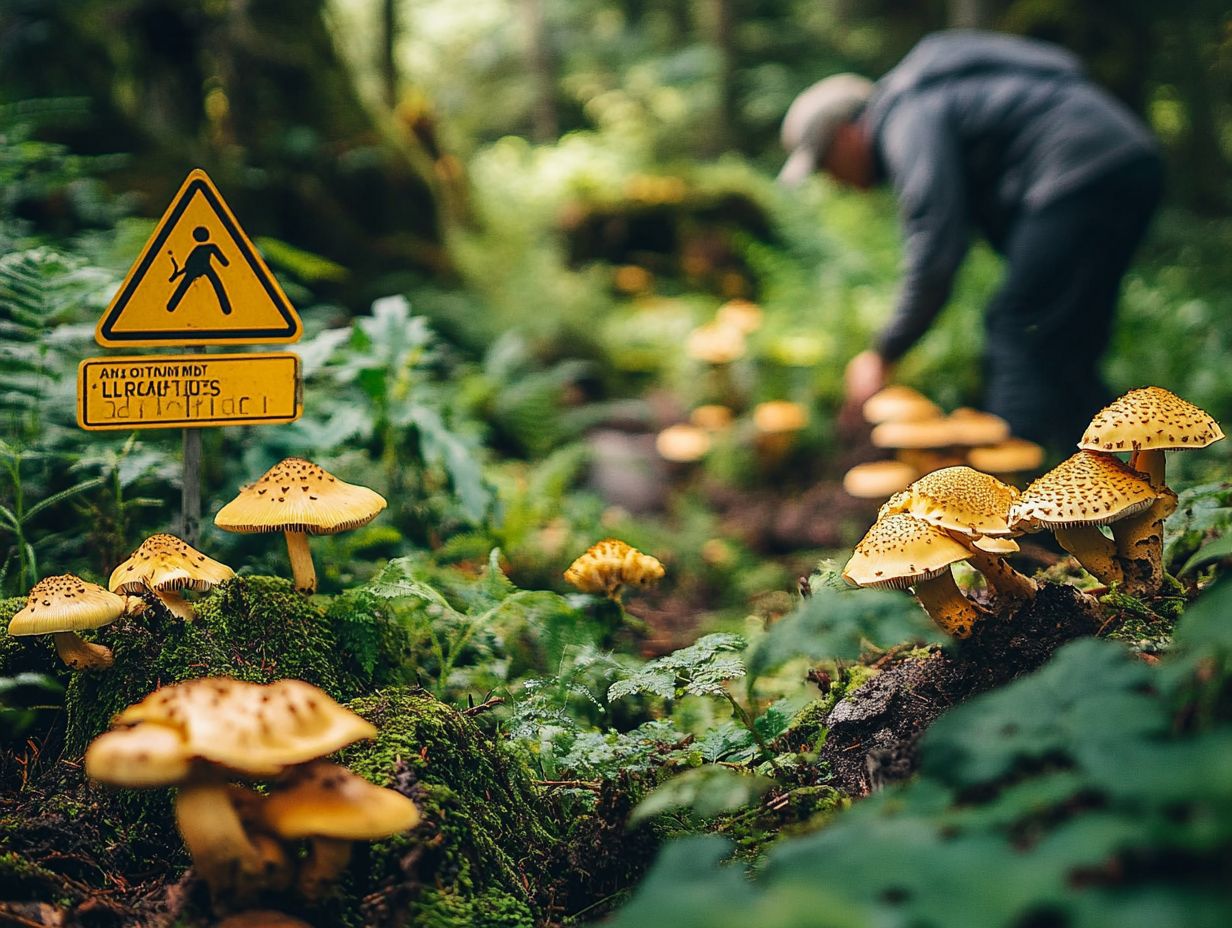
The top 7 risks of unsafe foraging practices are:
- Ingestion of toxic or poisonous plants
- Exposure to dangerous wildlife
- Getting lost or injured
- Consuming contaminated food or water
- Causing harm to the environment
- Violating local laws and regulations
- The spread of invasive species
How does ingestion of toxic or poisonous plants pose a risk in foraging?
Ingesting toxic or poisonous plants can lead to serious health consequences or even death. Many wild plants may look harmless, but they can contain harmful toxins that can cause severe illness or be fatal.
In what ways can unsafe foraging practices lead to exposure to dangerous wildlife?
Foraging in areas with dangerous wildlife, such as bears or snakes, can put individuals at risk of being attacked or bitten. It is important to research and be aware of potential wildlife in the foraging area to avoid these risks.
Consider joining a local foraging group or taking a workshop to enhance your knowledge and skills. Safe foraging practices and understanding alternatives will not only help you enjoy nature but also protect you and the environment.
What should I do if I get lost or injured while foraging?
If you get lost or injured, stay calm. Try to find your way back to a familiar spot.
If you can t, seek help from a park ranger or emergency services. Always bring a first aid kit, a map, or a GPS device when foraging.
How can I avoid consuming contaminated food or water while foraging?
Identify plants and mushrooms carefully before eating them. Avoid anything that looks unusual.
Bring your own clean water or water purifying tablets to avoid drinking anything contaminated. Purifying tablets remove harmful bacteria and make water safe to drink.
Why can foraging harm the environment?
Foraging can disrupt the natural balance of plants and wildlife. Over-harvesting or picking rare plants harms ecosystems.
What laws and regulations should I be aware of when foraging?
Research local laws before you forage. Some areas require permits, so respect these regulations to avoid fines.

